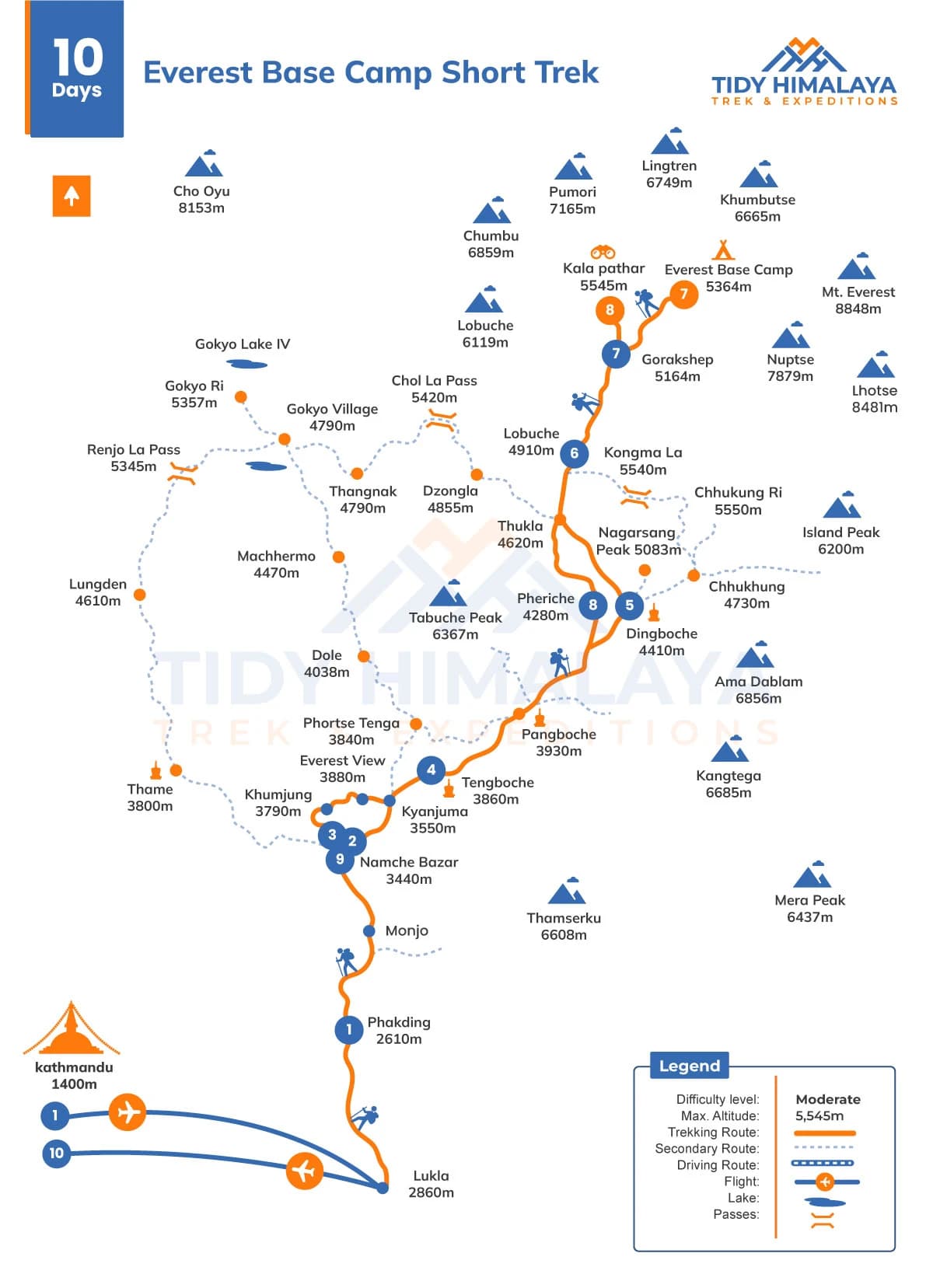Standing at an elevation of 5364m(17598 ft) above sea level in the Khumbu region, Everest is the pride of NEPAL.
Everest base camp is a starting point for climber attempting to summit my everet but for the trekkers it’s a ones in a life time opportunity.
Starting from Kathmandu, hikers go through villages like Phakding, Namche Bazaar, Tengboche, and Lobuche before reaching Everest BASE CAMP. Elevation at such a height might be challenging and cause mountain sickness. Consult with a healthcare provider before undertaking high-altitude treks.
Highlights of EBC Short Trek
- Sunrise/sunsets at Kala Pahar
- Explore Sherpa capital-Nancy’s bazaar
- Cost tomatoes scarred the site of the regional monastery
- Hike through challenging yet rewarding trails
- Blend with mountain culture and tradition.
- Flight to the world's most dramatic airport, Lukla
- Stand at the world's highest peak, EBC
Overview of the Everest Base Camp Short Trek (10 Days)
The Everest base camp short trek is a challenging yet adventure-packed journey. It is especially designed for the trekkers whose time and budget are limited and still want to hike EBC- the world's highest mountain, mt Everest (8848m) base camp.
This 10-day itinerary to the EBC short trek goes through the heart of the Everest-Khumbu region. Sherpa villages, ancient monasteries, and stone-padded steps are generations old and still hold the same importance. It starts from Lukla, the journey of time, to reach Everest base camp and ends in Kathmandu.
Despite the limited periods, this trek manages to adjust the acclimatization days. It is necessary to adjust the evaluation to avoid altitude sickness without compromising on the highlights.
Why Book With Tidy Himalaya?
Choosing the Right Trekking Agencies for the EBC trek? At Tidy Himalaya, we craft every journey with love, trust, safety, and with expert advice. Here’s why many trekkers choose us as their trekking guides:
Local Experts and Certified Guides
- Government-certified and experienced guide.
- Knowledge of the trails, local culture, language, and weather.
- Trustworthy, capable, and well-equipped guide with years of experience on the Himalaya route.
Safety-First Approach
- Flexible itinerary with a climatization spot to avoid sickness.
- Our team is trained in evacuation protocols.
- Strong network and communication, like with the local person in case of emergency care.
Personalized Support Before and During the Trek
- We help you with the gear selection, travel logistics, permits, and other concerns.
- Your comfort, peace, and well-being are our number one.
- Detailed briefings covering route specifics, altitude acclimatization strategies, packing essentials, and safety protocols
Who is This Trek For?
Unlike the Classical EBC trek, the short trek to Everest is crafted for those with a short itinerary. If the trekkers have a great fitness level and don’t want to compromise highlights, but the time frame is limited, this trek is perfect.
Fitness Level Requirements
- Cardiovascular Endurance
- Muscular Strength and Endurance
- Hiking-Specific Training
- Flexibility and Balance
- Swimming and jogging
- Develop a positive mindset and realistic expectations
Ideal for Time-Constrained Adventurer
If hiking to EBC was not on your to-do list but you still want to trek quickly, it’s the perfect destination for you.
We cut down the acclimatization days by half or increase the walking speed. With the carefully planned route, we can reach EBC in 10 days without compromising safety.
-(1).webp&w=3840&q=75&dpl=dpl_2PwU5ZDv8uoJ3KrzEVbz8N547HgX)
-(1).webp&w=3840&q=75&dpl=dpl_2PwU5ZDv8uoJ3KrzEVbz8N547HgX)
-(1).webp&w=3840&q=75&dpl=dpl_2PwU5ZDv8uoJ3KrzEVbz8N547HgX)


.webp&w=1200&q=75&dpl=dpl_2PwU5ZDv8uoJ3KrzEVbz8N547HgX)
-(600-x-450-px)-(1200-x-675-px)-(600-x-450-px)-(1).webp&w=1200&q=75&dpl=dpl_2PwU5ZDv8uoJ3KrzEVbz8N547HgX)
-(600-x-450-px)-(1200-x-675-px)-(1200-x-675-px)-(600-x-450-px).webp&w=1200&q=75&dpl=dpl_2PwU5ZDv8uoJ3KrzEVbz8N547HgX)